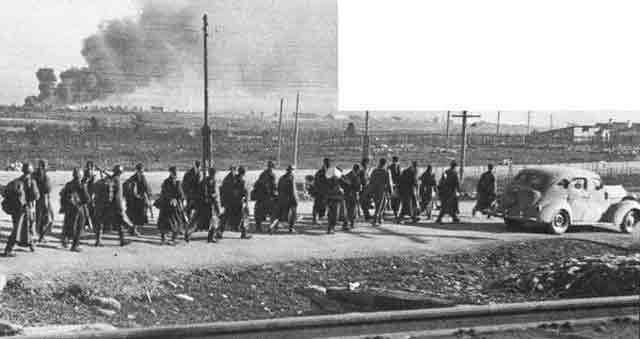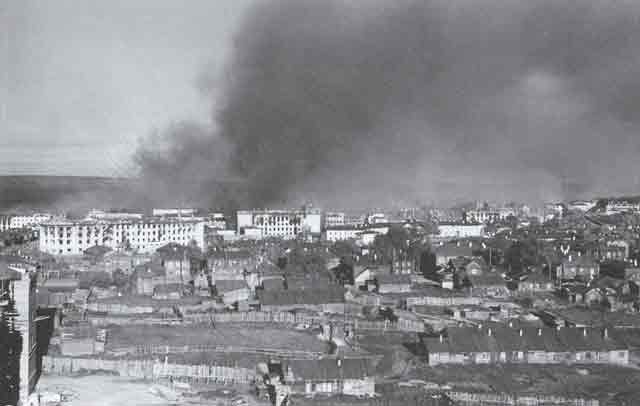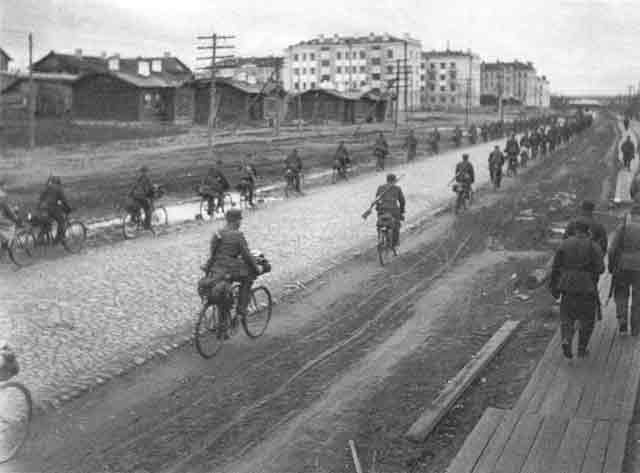Sunday 12 October 1941
 |
| Finnish tanks on parade at Petrozavodsk on the western shore of Lake Onega, 12 October 1941. |
Eastern Front: On
12 October 1941, the Spanish Blue Division troops of the 250th Infantry Division in the German Army (Heer) numbering system deploy on the Volkhov River in the Army Group North sector. The Spanish troops establish their headquarters on the outskirts of Veliky Novgorod in a village called Grigorovo. The Blue Division is responsible for a 50 km section of the front which runs from north of Novgorod south along the banks of the Volkhov River and behind Lake Ilmen.
 |
| An RAF technical intelligence team inspects a downed Luftwaffe Dornier Do-217 near Rye, England. The pilot and crew got disoriented while flying and thought they were crashlanding in France after running out of fuel. The Dornier wound up at RAF Farnborough for testing. |
While used by the Wehrmacht as garrison troops to hold a quiet part of the line, the Spanish Blue Division is marked by high morale in its all-volunteer ranks. Serving on the eastern front is considered a high honor, and virtually everyone graduating from the Spanish military academy volunteers. While in the Soviet Union, General Agustín Muñoz Grandes, the Blue Division's leader, has his men replace their symbolic Blue Division uniforms. These uniforms include the red berets of the Carlists, the khaki trousers of the Spanish Legion, and the blue shirts of the Falangists. While in German service, however, the men wear the ordinary field grey Heer uniform.
 |
| A Blue Division soldier in 1941 wearing the normal Wehrmacht field grey uniform with the distinctive Spanish patch on his sleeve. |
The Blue Division division gets its nickname from its blue shirts, though those are only worn while on leave in Spain. As with other affiliated troops in the Wehrmacht, the Blue Division's uniform is individualized with a special shoulder patch marking the soldiers' nation of origin. In this case, the badge has the Spanish national colors with the word "Espana."
 |
| Vought Kingfisher OS2U-3 (shown at another time) runs into trouble on 12 October 1941 during a ferry flight from NAS New York to NAS San Diego. After hitting a tree in the Chiricahua Mountains, Arizona, the seaplane crashes, killing Pilot Sgt. McMahon. A passenger is thrown clear and survives. There is still debris at the crash site. |
The Blue Division men have good reason to be tired, as they have just completed a 900 km march from the nearest railhead at Suwałki, Poland. Throughout the war, the main means of transportation within the Wehrmacht remains the railway system, which is both a strength and a weakness of the German Army. The railways are easy to control and make quick moves across long distances possible and efficient. However, troop moves are restricted by the absence of railway workers in the occupied eastern territories, the insufficient numbers of Soviet locomotives and rail cars, and the vulnerability of the rail system to partisan attack and aerial bombing. The Soviet rails are of a different gauge than the German ones, and so German trains cannot just continue east until new rails are laid - a massive undertaking that requires time and men. The result is that the German infantry, like the Blue Division, is forced to walk long distances and cannot possibly keep pace with the panzers and panzer grenadiers leading the offensive.
 |
| As the headline on this 12 October 1941 edition of The Wisconsin State Journal indicates, it seemed obvious that the "climax" of the German attack on Moscow was just around the corner and the city would soon fall. |
It is unclear why the Germans diverted the Blue Division from the attack on Moscow, Operation Typhoon, their original assignment, to a quiet sector further north. Throughout the war, there is a general feeling within the Wehrmacht that "foreign" troops cannot be entrusted with critical missions. However, it also may be the case in this particular situation that the Germans want to keep the glory of taking Moscow to themselves - it would not do at all if a Spanish Division played a key role in taking the Soviet capital.
 |
| Propellers of Royal Navy battleship HMS Duke of York. This photo was taken at Rosyth between 12 October 1941 and 14 October 1941 (© IWM (A 5893)). |
In any event, the German Army (Heer) does not seem to need any help at this point. The OKH today sends Army Group Center commander Field Marshal Fedor von Bock curt instructions:
The Führer has reaffirmed his decision that the surrender of Moscow will not be accepted, even if it is offered by the enemy.
With these "no surrender" orders in hand, von Bock orders an immediate advance on Moscow all along the line. However, like the Blue Division men, the German troops already have marched hundreds of kilometers, including a quick advance of 70 km just in the past five days - all while fighting. As usual, the panzers move quickly, with 1st Panzer Division taking Rzhev and Staritsa, while General Guderian's Panzer Group 2 takes Kaluga about 100 miles southwest of Moscow. The German infantry is still marching to catch up, however, and two Soviet rifle divisions break out from the Vyazma pocket through swamps where the panzers can't operate.
 |
| Three sailors at Father Duffy statue in Duffy Square (northern half of Times Square), Manhattan, NY, October 12, 1941. Incidentally, this monument to a World War I chaplain is still there. Note that Humphrey Bogart's "The Maltese Falcon" is playing at the Strand Theater across the street (Rodney McCay Morgan/NYC Parks Photo Archive). |
Even the panzers are feeling the strain, however. Where once missions could be accomplished by just one panzer division, now they have to be combined. Today, for instance, SS Obergruppenfuhrer Paul Hausser’s SS-Infanterie-Division (mot.) ‘Das Reich’ from XLVI. Armeekorps (mot.) is given a critical mission of pushing east along the Minsk-Moscow main road. However, it has been so weakened by months of constant combat that it must be joined by a Kampfgruppe from the 10th Panzer Division. The weather is terrible, the roads are muddy, and General Guderian notes in his diary that it snows throughout the day.
 |
| Judy Garland with producer Ted Sherdeman on 12 October 1941 while appearing on the CBS Radio "Silver Theater" adaptation of "Eternally Yours" (Kim Lundgreen via JudyGarlandNews.com). |
October 1941October 1, 1941: Germans and Finns Advance in USSROctober 2, 1941: Operation Typhoon BroadensOctober 3, 1941: Air Battles Near MoscowOctober 4, 1941: Stalin Contemplates DefeatOctober 5, 1941: Hoth Goes SouthOctober 6, 1941: First Snowfall After DarkOctober 7, 1941: Stalin Gets ReligionOctober 8, 1941: FDR Promises Stalin Aid October 9, 1941: FDR Orders Atomic Bomb ResearchOctober 10, 1941: Reichenau's Severity OrderOctober 11, 1941: Tank Panic in MoscowOctober 12, 1941: Spanish Blue Division at the FrontOctober 13, 1941: Attack on MoscowOctober 14, 1941: Germans Take KalininOctober 15, 1941: Soviets Evacuate OdessaOctober 16, 1941: Romanians Occupy OdessaOctober 17, 1941: U-568 Torpedoes USS KearnyOctober 18, 1941: Tojo Takes TokyoOctober 19, 1941: Germans Take MozhayskOctober 20, 1941: Germans Attack Toward TikhvinOctober 21, 1941: Rasputitsa Hits RussiaOctober 22, 1941: Germans Into Moscow's Second Defensive LineOctober 23, 1941: The Odessa MassacreOctober 24, 1941: Guderian's Desperate Drive NorthOctober 25, 1941: FDR Warns Hitler About MassacresOctober 26, 1941: Guderian Drives Toward TulaOctober 27, 1941: Manstein Busts LooseOctober 28, 1941: Soviet ExecutionsOctober 29, 1941: Guderian Reaches TulaOctober 30, 1941: Guderian Stopped at TulaOctober 31, 1941: USS Reuben James Sunk2020



















